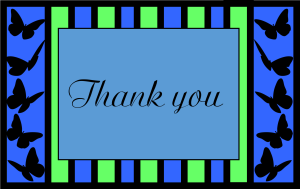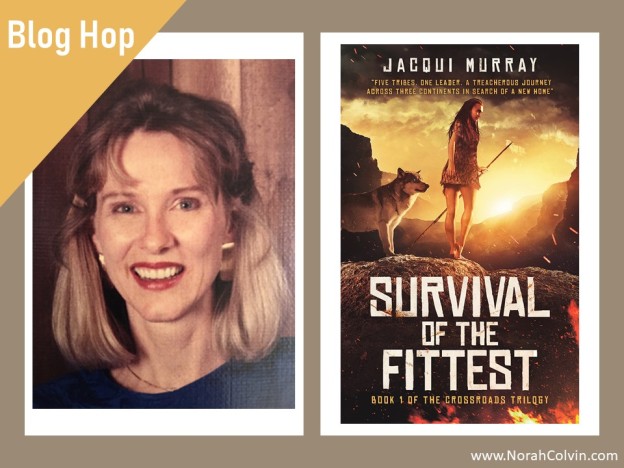This week I am delighted to introduce you to Jacqui Murray. I’d been following Jacqui’s blog Ask a Tech Teacher for some time before I realised she had other writing achievements in her portfolio. I had always enjoyed keeping up with what was new in technology for the classroom and reading Jacqui’s advice for teachers and parents as well as the general technology user. Now, I’ve discovered she has much more to explore.
Jacqui and I have found that we share a lot in common. She recently hosted me at her blog here, and soon her guest post Why Kindergartners Must Learn Technology will be shared on the readilearn blog.
This post is part of a blog hop celebrating the launch of Jacqui’s latest prehistory novel Survival of the Fittest.

The Book
Title and author: Survival of the Fittest
Series: Book 1 in the Crossroads series, part of the Man vs. Nature saga
Genre: Prehistoric fiction
Cover by: Damonza
Available in print and digital at: Kindle US Kindle UK Kindle CA Kindle AU
Short Blurb
Five tribes. One leader. A treacherous journey across three continents in search of a new home.
Summary
Chased by a ruthless and powerful enemy, Xhosa flees with her People, leaving behind a certain life in her African homeland to search for an unknown future. She leads her People on a grueling journey through unknown and dangerous lands but an escape path laid out years before by her father as a final desperate means to survival. She is joined by other homeless tribes–from Indonesia, China, South Africa, East Africa, and the Levant—all similarly forced by timeless events to find new lives. As they struggle to overcome treachery, lies, danger, tragedy, hidden secrets, and Nature herself, Xhosa must face the reality that this enemy doesn’t want her People’s land. He wants to destroy her.
Questions for Jacqui
Setting a book in the days of prehistory must present a number of challenges for writers. I asked Jacqui to explain how she approached some of those challenges.
How did Xhosa tell time?
Xhosa’s People had no need for the exacting time that we today have. It was enough to know that events happened around certain other repetitive events (like a full moon or a sunrise). They could peg daily events to when the Sun reached a certain point in the sky (with a good guess if it was overcast).A popular way of telling time which I borrowed from societies that predated clocks, sundials, and any regimented ways of telling time is measuring time by sun’s movement. A finger of time would be about fifteen minutes and a hand of time would be bout an hour.
How did Xhosa count?
Xhosa and her People also had no need for counting. This is true even today with primitive people. Many count only to two (which is the method I’ve adopted for Xhosa). Beyond that, numbers may be described as handfuls or how much room they occupy in relation to something else. Counting people was unnecessary because all Xhosa had to do was sniff, find everyone’s scent, or notice whose she couldn’t find.
Did Xhosa have any type of culture—art, music, that sort?
This time in man’s prehistory predated art, music, and most culture. There is very little if anything known about earliest man’s (850,000 years ago) interest in art and music. In Xhosa’s case, I extrapolated from what we do know about these early iterations of man. They appreciated colors but didn’t think of applying it to themselves. Their brains could imagine things unseen but that didn’t extend to painting themselves, wearing jewelry, or tattoos. Since clothing was only for warmth (or in Seeker’s case, to protect his sensitive parts), no thought was given to designing or decorating these.
Music—They did appreciate bird songs but considered it an animal voice, not something that they could replicate for their own pleasure. They could replicate it but it was to imitate the bird, not express creativity. They also appreciated rhythm but that was to set a running pace or sooth people.
Most scientists believe Homo erectus couldn’t talk. How did Xhosa and her People communicate?
These early humans were highly intelligent for their day and possessed rich communication skills but rarely verbal. Most paleoanthropologists believe that the ‘speaking’ part of their brain wasn’t evolved enough for speech but there’s another reason: Talking is noisy as well as unnatural in nature which attracts attention. For these early humans, who were far from the alpha in the food chain, being noticed wasn’t good.
Instead, they communicated with gestures, facial expressions, movements, and all the body language we-all still use but rarely recognize. They talked to each other about everything necessary, just nonverbally.

Thank you, Jacqui. You’ve obviously worked hard to make your novel ring with authenticity. I wish you success with it.
About Jacqui
Jacqui Murray is the author of the popular Building a Midshipman, the story of her daughter’s journey from high school to United States Naval Academy, the Rowe-Delamagente thrillers, and the Man vs. Nature saga. She is also the author/editor of over a hundred books on integrating tech into education, adjunct professor of technology in education, blog webmaster, an Amazon Vine Voice, a columnist for TeachHUB and NEA Today, and a freelance journalist on tech ed topics. Look for her next prehistoric fiction, Quest for Home, Summer 2019. You can find her tech ed books at her publisher’s website, Structured Learning.
Connect with Jacqui on social media
http://pinterest.com/askatechteacher
http://linkedin.com/in/jacquimurray
https://worddreams.wordpress.com
Jacqui has generously provided us with Chapter one as a preview of her novel Survival of the Fittest.

Chapter 1
Her foot throbbed. Blood dripped from a deep gash in her leg. At some point, Xhosa had scraped her palms raw while sliding across gravel but didn’t remember when, nor did it matter. Arms pumping, heart thundering, she flew forward. When her breath went from pants to wheezing gasps, she lunged to a stop, hands pressed against her damp legs, waiting for her chest to stop heaving. She should rest but that was nothing but a passing thought, discarded as quickly as it arrived. Her mission was greater than exhaustion or pain or personal comfort.
She started again, sprinting as though chased, aching fingers wrapped around her spear. The bellows of the imaginary enemy—Big Heads this time—filled the air like an acrid stench. She flung her spear over her shoulder, aiming from memory. A thunk and it hit the tree, a stand-in for the enemy. With a growl, she pivoted to defend her People.
Which would never happen. Females weren’t warriors.
Feet spread, mouth set in a tight line, she launched her last spear, skewering an imaginary assailant, and was off again, feet light, her abundance of ebony hair streaming behind her like smoke. A scorpion crunched beneath her hardened foot. Something moved in the corner of her vision and she hurled a throwing stone, smiling as a hare toppled over. Nightshade called her reactions those of Leopard.
But that didn’t matter. Females didn’t become hunters either.
With a lurch, she gulped in the parched air. The lush green grass had long since given way to brittle stalks and desiccated scrub. Sun’s heat drove everything alive underground, underwater, or over the horizon. The males caught her attention across the field, each with a spear and warclub. Today’s hunt would be the last until the rain—and the herds—returned.
“Why haven’t they left?”
She kicked a rock and winced as pain shot through her foot. Head down, eyes shut against the memories. Even after all this time, the chilling screams still rang in her ears…
The People’s warriors had been away hunting when the assault occurred. Xhosa’s mother pushed her young daughter into a reed bed and stormed toward the invaders but too late to save the life of her young son. The killer, an Other, laughed at the enraged female armed only with a cutter. When she sliced his cheek open, the gash so deep his black teeth showed, his laughter became fury. He swung his club with such force her mother crumpled instantly, her head a shattered melon.
From the safety of the pond, Xhosa memorized the killer—nose hooked awkwardly from some earlier injury, eyes dark pools of cruelty. It was then, at least in spirit, she became a warrior. Nothing like this must ever happen again.
When her father, the People’s Leader, arrived that night with his warriors, he was greeted by the devastating scene of blood-soaked ground covered by mangled bodies, already chewed by scavengers. A dry-eyed Xhosa told him how marauders had massacred every subadult, female, and child they could find, including her father’s pairmate. Xhosa communicated this with the usual grunts, guttural sounds, hand signals, facial expressions, hisses, and chirps. The only vocalizations were call signs to identify the group members.
“If I knew how to fight, Father, Mother would be alive.” Her voice held no anger, just determination.
The tribe she described had arrived a Moon ago, drawn by the area’s rich fruit trees, large ponds, lush grazing, and bluffs with a view as far as could be traveled in a day. No other area offered such a wealth of resources. The People’s scouts had seen these Others but allowed them to forage, not knowing their goal was to destroy the People.
Her father’s body raged but his hands, when they moved, were calm. “We will avenge our losses, daughter.”
The next morning, Xhosa’s father ordered the hunters to stay behind, protect the People. He and the warriors snuck into the enemy camp before Sun awoke and slaughtered the females and children before anyone could launch a defense. The males were pinned to the ground with stakes driven through their thighs and hands. The People cut deep wounds into their bodies and left, the blood scent calling all scavengers.
When Xhosa asked if the one with the slashed cheek had died, her father motioned, “He escaped, alone. He will not survive.”
Word spread of the savagery and no one ever again attacked the People, not their camp, their warriors, or their hunters.
While peace prevailed, Xhosa grew into a powerful but odd-looking female. Her hair was too shiny, hips too round, waist too narrow beneath breasts bigger than necessary to feed babies. Her legs were slender rather than sturdy and so long, they made her taller than every male. The fact that she could outrun even the hunters while heaving her spear and hitting whatever she aimed for didn’t matter. Females weren’t required to run that fast. Nightshade, though, didn’t care about any of that. He claimed they would pairmate, as her father wished, when he became the People’s Leader.
Until then, all of her time was spent practicing the warrior skills no one would allow her to use.
One day, she confronted her father. “I can wield a warclub one-handed and throw a spear hard enough to kill. If I were male, you would make me a warrior.”
He smiled. “You are like a son to me, Daughter. I see your confidence and boldness. If I don’t teach you, I fear I will lose you.”
He looked away, the smile long gone from his lips. “Either you or Nightshade must lead when I can’t.”
Under her father’s tutelage, she and Nightshade learned the nuances of sparring, battling, chasing, defending, and assaulting with the shared goal that never would the People succumb to an enemy. Every one of Xhosa’s spear throws destroyed the one who killed her mother. Every swing of her warclub smashed his head as he had her mother’s. Never again would she stand by, impotent, while her world collapsed. She perfected the skills of knapping cutters and sharpening spears, and became expert at finding animal trace in bent twigs, crushed grass, and by listening to their subtle calls. She could walk without leaving tracks and match nature’s sounds well enough to be invisible.
A Moon ago, as Xhosa practiced her scouting, she came upon a lone warrior kneeling by a waterhole. His back was to her, skeletal and gaunt, his warclub chipped, but menace oozed from him like stench from dung. She melted into the redolent sedge grasses, feet sinking into the squishy mud, and observed.
His head hair was sprinkled with grey. A hooked nose canted precariously, poorly healed from a fracas he won but his nose lost. His curled lips revealed cracked and missing teeth. A cut on his upper arm festered with pus and maggots. Fever dimpled his forehead with sweat. He crouched to drink but no amount of water would appease that thirst.
What gave him away was the wide ragged scar left from the slash of her mother’s cutter.
Xhosa trembled with rage, fearing he would see the reeds shake, biting her lip until it bled to stop from howling. It hardly seemed fair to slay a dying male but fairness was not part of her plan today.
Only revenge.
A check of her surroundings indicated he traveled alone. Not that it mattered. If she must trade her life for his, so be it.
But she didn’t intend to die.
The exhausted warrior splashed muddy water on his grimy head, hands slow, shoulders round with fatigue, oblivious to his impending death. After a quiet breath, she stepped from the sedge, spear in one hand and a large rock in the other. Exposed, arms ready but hanging, she approached. If he turned, he would see her. She tested for dry twigs and brittle grass before committing each foot. It surprised her he ignored the silence of the insects. His wounds must distract him. By the time hair raised on his neck, it was too late. He pivoted as she swung, powered by fury over her mother’s death, her father’s agony, and her own loss. Her warclub smashed into his temple with a soggy thud. Recognition flared moments before life left.
“You die too quickly!” she screamed and hit him over and over, collapsing his skull and spewing gore over her body. “I wanted you to suffer as I did!”
Her body was numb as she kicked him into the pond, feeling not joy for his death, relief that her mother was avenged, or upset at the execution of an unarmed Other. She cleaned the gore from her warclub and left. No one would know she had been blooded but the truth filled her with power.
She was now a warrior.
When she returned to homebase, Nightshade waited. Something flashed through his eyes as though for the first time, he saw her as a warrior. His chiseled face, outlined by dense blue-black hair, lit up. The corners of his full lips twitched under the broad flat nose. The finger-thick white scar emblazoned against his smooth forehead, a symbol of his courage surviving Sabertooth’s claws, pulsed. Female eyes watched him, wishing he would look at them as he did Xhosa but he barely noticed.
The next day, odd Others with long legs, skinny chests, and oversized heads arrived. The People’s scouts confronted them but they simply watched the scouts, spears down, and then trotted away, backs to the scouts. That night, for the first time, Xhosa’s father taught her and Nightshade the lessons of leading.
“Managing the lives of the People is more than winning battles. You must match individual skills to the People’s requirements be it as a warrior, hunter, scout, forager, child minder, Primary Female, or another. All can do all jobs but one best suits each. The Leader must decide,” her father motioned.
As they finished, she asked the question she’d been thinking about all night. “Father, where do they come from?”
“They are called Big Heads,” which didn’t answer Xhosa’s question.
Nightshade motioned, “Do they want to trade females? Or children?”
Her father stared into the distance as though lost in some memory. His teeth ground together and his hands shook until he clamped them together.
He finally took a breath and motioned, “No, they don’t want mates. They want conflict.” He tilted his head forward. “Soon, we will be forced to stop them.”
Nightshade clenched his spear and his eyes glittered at the prospect of battle. It had been a long time since the People fought.
But the Big Heads vanished. Many of the People were relieved but Xhosa couldn’t shake the feeling that danger lurked only a long spear throw away. She found herself staring at the same spot her father had, thoughts blank, senses burning. At times, there was a movement or the glint of Sun off eyes, but mostly there was only the unnerving feeling of being watched. Each day felt one day closer to when the People’s time would end.
“When it does, I will confess to killing the Other. Anyone blooded must be allowed to be a warrior.”


Thank you for reading. I appreciate your comments. Please share your thoughts.







